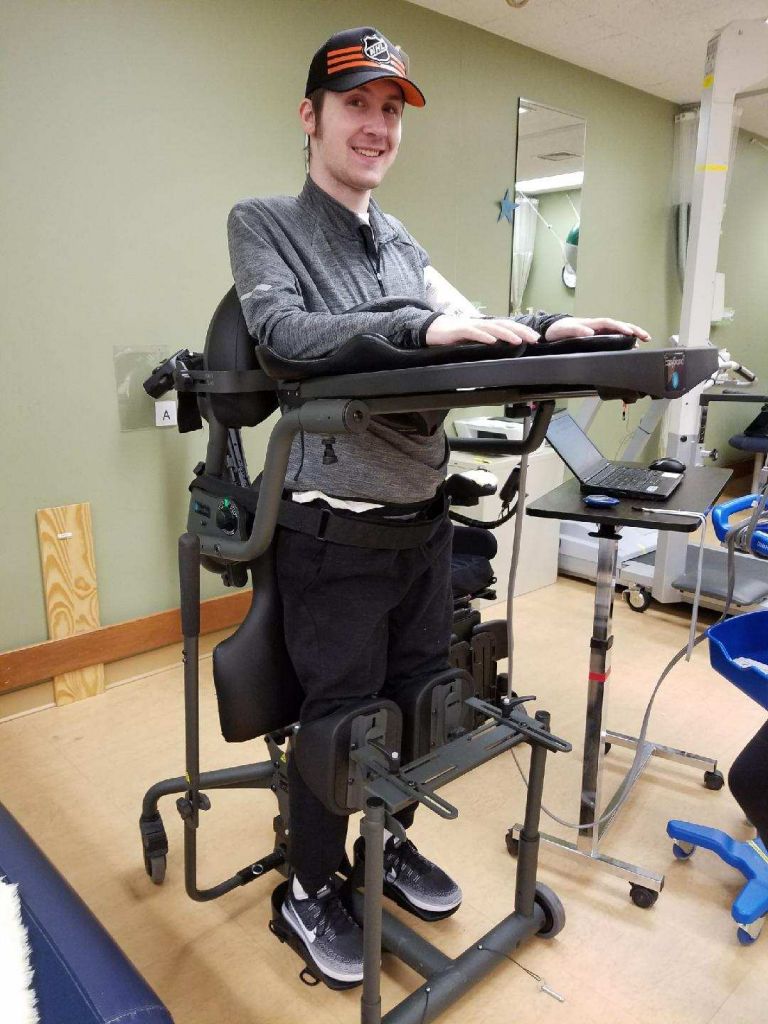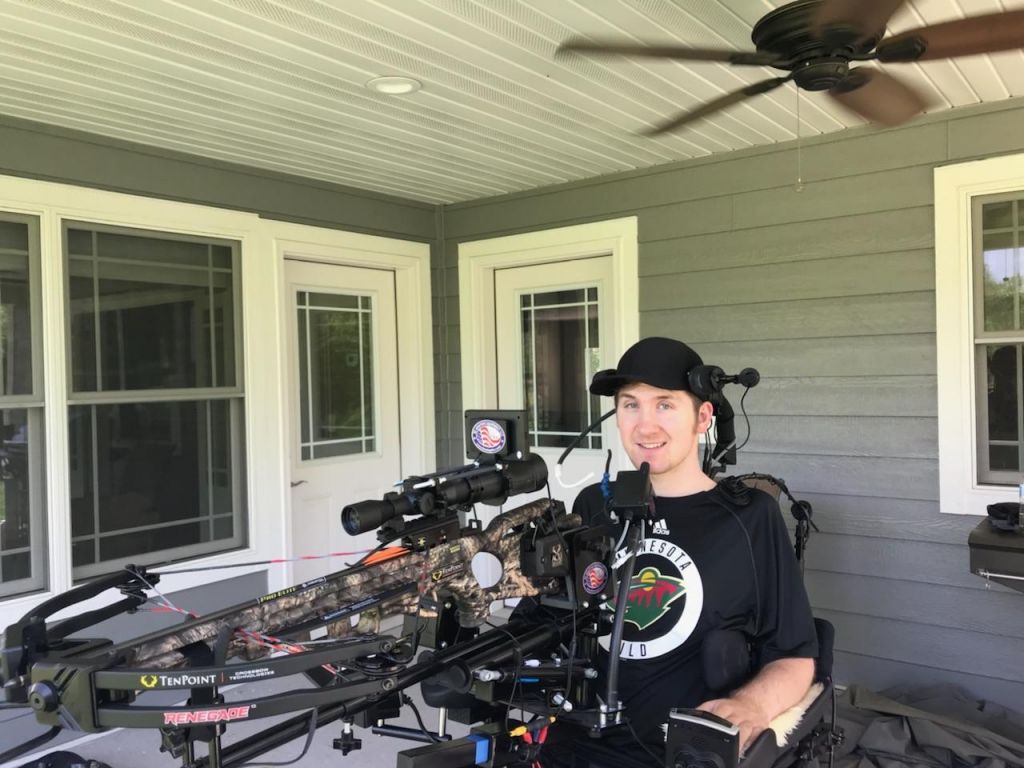Where is he now?

On February 21, 2016, Matt Olson, a junior hockey defenseman playing for the Chicago Cougars (in the United States Premier League), was chasing a puck back at full speed into the zone to defend the play against the Iliana Blackbirds when he hit a rut in the ice, stumbled and crashed headfirst into the boards at Sears Centre Arena. The 20-year-old’s life changed in a split second; he instantly became a quadriplegic.
He was taken to Advocate Lutheran General Hospital, where he would spend the next six weeks undergoing surgeries and treatments almost daily and battling infections like pneumonia and post-op fevers. Matt sustained a C4 burst dislocation, classified an ASIA A (or complete) spinal-cord injury. His C4 vertebrae broke into multiple pieces, and his spinal cord was severely pinched.
 “From day one, Matt maintained a remarkable attitude – courageous, optimistic and determined to fight for recovery. He is an amazing young man and has the full support of a wonderful family and community. All of this has been instrumental in the progress he has made,” says Dr. John R. Ruge, a pediatric and adult neurosurgeon with Advocate Lutheran and Advocate Children’s Hospital.
“From day one, Matt maintained a remarkable attitude – courageous, optimistic and determined to fight for recovery. He is an amazing young man and has the full support of a wonderful family and community. All of this has been instrumental in the progress he has made,” says Dr. John R. Ruge, a pediatric and adult neurosurgeon with Advocate Lutheran and Advocate Children’s Hospital.
“It took a strong interdisciplinary team to care for Matt after his injury. This team included physicians, nurses, therapists and chaplains,” says Diane Eckhouse, an advanced practice registered nurse with Lutheran General. “All the specialties worked together to help Matt achieve the goals for transfer to acute rehabilitation. The team made sure to focus on the needs of Matt and his family and to try to normalize the hospital stay as much as possible.”
After leaving Lutheran General, Matt spent time in acute rehab at the Mayo Clinic in Rochester, MN., then more time at Courage Kenny Rehabilitation Institute closer to home in Minneapolis. In total, he spent 199 days in a hospital before he was able to move home to Isanti, MN.
Back home
As Matt’s childhood home was an old farmhouse, it was not conducive to life in a wheelchair. The living room became his bedroom, and life in the house was pretty much confined to that room and the kitchen. His parents worked with a company that specializes in designing accessible homes for the disabled. Eleven months after his injury, the family moved next door into their new one-story house with plenty of space to maneuver his state-of-the-art wheelchair.
Matt’s Quantum wheelchair, a 460-pound behemoth that costs more than a lot of cars, allows him to control virtually everything by moving switches with his head. But he soon hopes to change that through intensive amounts of physical and occupational therapy.
Keeping busy with school and rehabilitation
Still a hockey fan, Matt enjoys watching hockey and being around the rink whenever he can. But these days, he’s busy with a full life.
Matt attends both college and outpatient rehab each week. With a natural talent for math and a love for the outdoors, Matt has chosen environmental science as his major. Now in his third semester of college, he hopes to finish in another two to three years.
Twice a week, he heads to Courage Kenny in Golden Valley for three hours of intensive therapy as part of the “Able Program”.
He gets on the walking treadmill every time. The treadmill helps with core strength, balance, weight bearing for strength and muscle memory in the movement of walking. He works with a therapist for upper body functional tasks with the help of electrodes that stimulate the muscles – going through the motions of reaching forward, grasping and pulling back. In addition, for additional core-strengthening work, he sits on the edge of an exercise mat. When he first started, he could hold for 10 seconds, but now, he is up to 27 minutes.
He rides an adapted exercise bicycle at home four times a week for 35 minutes to an hour to improve cardiovascular fitness, arm and leg strength and overall health.
With all of the therapy and at-home exercising, Matt has significantly built up his bicep and shoulder movement and strength and is currently working on transitioning to using a joystick instead of head movements to control his wheelchair.
“In addition to the many procedures at Advocate Lutheran, Matt underwent a novel therapy where he received peripheral stem cells within 24 hours of his devastating spinal cord injury. Matt has unexpectedly regained additional function. While it is impossible to know at this time if the stem cells are responsible for this, it is a promising treatment for spinal cord injuries currently under clinical research,” said Dr. Ruge.
 Technology plays a huge role
Technology plays a huge role
Matt has programmed an Amazon Echo to turn his lights and TV on and off, change the TV channels and with an added adapter, turn his fan on and off.
His wheelchair has Bluetooth, which lets Matt access his mobile phone through his chair. Not only does Matt drive the chair with head movements, he also uses head movements to control a mouse that is connected to both his phone and his computer. He uses voice commands to dictate to his computer.
A speech recognition mathematics software program called MathTalkTM allows him to do his math homework at home and in class without the need for a keyboard.
Getting back to a normal life
Matt has been able to start travelling again; his first trip was to an NHL All-Star Game in Tampa, Fla. In November 2018, Matt visited the doctors, nurses and therapists who cared for him at Lutheran General. “They got to see how far I have come,” Matt says. “It was the first time they had heard me talk.” When Matt was a patient at Lutheran, he had a breathing tube and then a trach, which was removed when he was transferred to Mayo Clinic and was able to breathe on his own. “It was pretty cool to see them and it wasn’t too weird. I enjoyed being back.”
“When Matt and his family came back for a visit, it was very rewarding to see how far he had progressed and how he had integrated technology into his daily life. It was clear how impactful the support of his family and friends have been in the progress he has made so far,” says Eckhouse.
“I finally feel like I am living my normal life. Every day is becoming more normal, and I don’t constantly think about what happened and the situation I am in. I just have it in the back of my mind to keep working hard every day, because you never know what could happen,” says Matt.
Related Posts
Comments
One Comment
About the Author

Kate Eller was a regional director of public affairs and marketing operations for Advocate Health Care. She enjoys road trips, dogs, minimalism, yoga, hiking, and “urban hiking.”

















So happy for your progress. My son sustained a complete T6 injury (certainly not as devastating as yours), but life-changing. He has maximized his life just as you have. Keeping you in my thoughts. Keep up the great (and difficult) work!!!